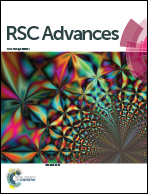Triple phase boundary induced self-catalyzed growth of Ge–graphite core–shell nanowires: field electron emission and surface wettability
Abstract
We report a simple method to fabricate Ge–graphite core–shell nanowires on a large scale using a CVD (Chemical Vapor Deposition) system free of catalyst and complicated precursors, which demonstrates interesting V–L–S (vapor–liquid–solid) boundary induced self-catalyzed growth. The novel catalyst-free VLS (vapor liquid solid) mechanism is expected to be generalized for the design of other 1D (one dimensional) metal–graphite hybrids in a controlled manner, based on the fact that tunable shell thickness was achieved on Ge–graphite and a 1D Cu–graphite core–shell was realized in the same way. The Ge–graphite core–shell nanowires deliver very good field emission properties with a threshold field of about 5.33 V μm−1 and a turn-on field of 2.58 V μm−1. The surface wetting measurement confirms the superhydrophobicity of the sample with a WCA (Water Contact Angle) of about 150.8° ± 2°, which decreased to 84.7° after 300 °C (3 h) treatment under vacuum (10−3 Torr). Moreover, the wettability behavior is robust against 365 nm UV (ultraviolet) radiation with the WCA unchanged, indicating stable superhydrophobicity in a UV-rich environment. We hope that this study contributes to the design of 1D metal–graphite nanostructures with the aim to explore more novel functionalities.


 Please wait while we load your content...
Please wait while we load your content...